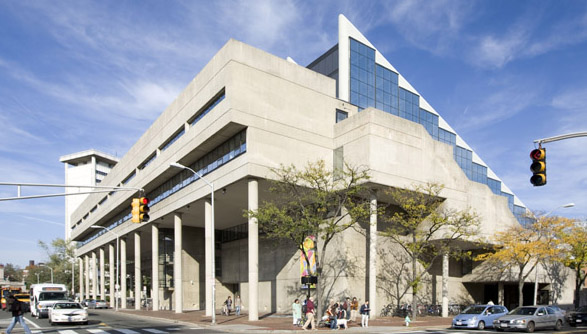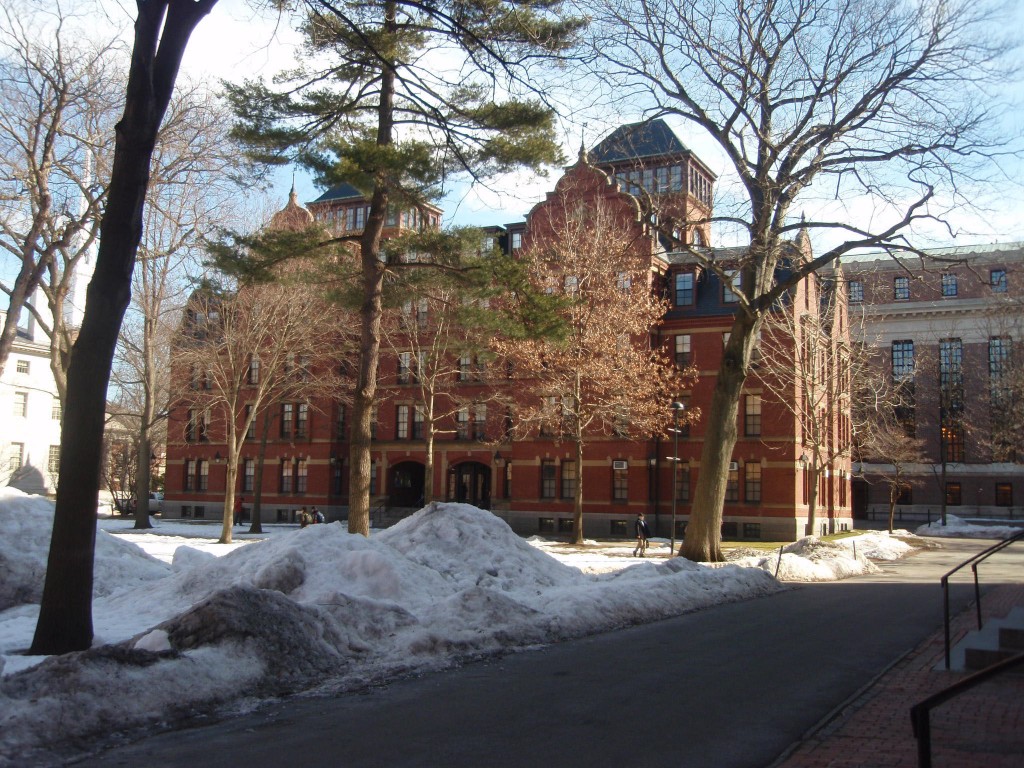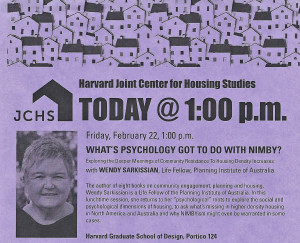NIMBY psychology comes to Harvard — from Australia!
February 2013 was an exciting month for me.
I spent it teaching in a first-year Masters planning studio in the Graduate School of Design (GSD) at Harvard University and giving lectures and classes at MIT and Tufts University.
It was exceptionally cold for a person who lives in the sub-tropics. A huge blizzard dumped 20 inches of snow in Boston days after I arrived.
Harvard in February. Brrr!
The highlight of my month-long visit was a lunch-time lecture for the Joint Center for Housing Studies at Harvard University on 22 February.
I spoke about the relationships between environmental psychology and community resistance to housing density increases to an audience in the iconic Gund Hall, which houses the Graduate School of Design.

Not in my back yard (NIMBY)
Throughout the Western world and especially in Australia, we are seeing strong initiatives to increase housing density to achieve sustainability initiatives.
Paralleling these types of initiatives are concerns about the social impacts of higher density housing, confirmed by a widespread Australian research and a recent visit to Canada.
Even in Hong Kong, there are community concerns about housing density increases.
Where governments have mandated housing density increases, the results have not always been positive.
The much-lauded CityPlan community engagement process in Vancouver, Canada, resulted in a strong support for housing density in the late 1990s and early years of this century, with some planners believing that they had converted NIMBY to YIMBY (“Yes in My Back Yard”). However, currently a strong community backlash in Vancouver reveals that these gains were short-lived.
After tens of millions of dollars spent on community engagement about density increases, residents and others are strongly opposing further housing density increases.
In many Western cities, the early optimism of what community engagement could deliver with respect to housing density increases has faded.
The irony is that success in this arena is much more important that it was in earlier decades as the pressures of Peak Oil and climate change begin to be felt more powerfully by communities and governments.
So, if density increases are needed and resistance is increasing, what is the answer? What really is at the core of peoples’ concerns?
Which approaches might work to engage communities with the issues of housing density?
What if we could achieve our sustainability and housing density goals without causing community unrest, dissatisfaction – even uproar?
Could communities respond positively to density increases under the appropriate conditions?
I believe that all of that is possible. But we must understand more about the psychology of housing to be effective.
We need to appreciate why governments must continue to campaign for increased housing density. It’s as though these two initiatives are at opposite ends of a spectrum.
Yet they are connected by the very concerns that seem to place proponents of density increases at loggerheads with community members.
A key to understanding these conflicts (occurring in our communities today) is to understand more about housing. It’s not merely `product’, as some developers say.
The psychology of place and housing
Home is more than a `commodity’ as economists would say.
For some, it’s everything: a haven, a nest, protection, security”¦
many qualities that have little or nothing to do with density, tenure or whether one’s name is on the mortgage document”¦
Home is a deeply archetypal concept. Humans aer animals and, like other animals, we are hard-wired to protect our territory, the “territorial core” of our home.
It’s complicated and that’s partly why people’s responses to a threat to their housing often get so very `complicated’.
Our Homing Instinct is a deep-seated desire to protect what is personal, precious and `home’.
Here are links to the Harvard lecture and the PowerPoint presentation:
Sarkissian_Joint Center_22 Feb 2013_FINAL_for website_F
Sarkissian Harvard Joint Center for Housing Studies lecture 22 February 2013_revised for web
Social planning was having a good month!
The Fifth Estate
The lecture was also picked up by the real estate blog, The Fifth Estate: Our Planet, Our Real Estate.
Here’s a link to their blog:
https://www.thefifthestate.com.au/archives/45397/
Sydney planner, Corrine Fisher, had this to say in response to the Fifth Estate blog:
The lack of `love’ in NSW planning is exemplified by the recent, sudden announcement of massive new high-density housing across Sydney, with very little if any community input.
North Ryde and Epping [Sydney suburbs] residents have been given 6 weeks to have their say on buildings that will be up to 3 times the height allowed under current planning controls; the Government is bullying its way through; and developers are rubbing their hands in anticipation of the financial profits ahead.
What about community? Words that come to mind: dis-empowerment; despair; anger; cynicism and loss of faith.
Is this really what we want for this city? Yet it could have been done so differently.
It’s high time for Government (at all levels) to re-visit its relationship with community and actively promote a more open, respectful and transparent dialogue with and between developers and local residents.
Many of us are prepared to accept that infill housing needs to be built.
What people abhor is bullying tactics, greed and ugly developments that take away from residential amenity and destroy community well-being and quality of life.
My sincere thanks to Eric Belsky and his colleagues of the Joint Center for generous support and hospitality and thanks to Ann Forsyth of the GSD.




